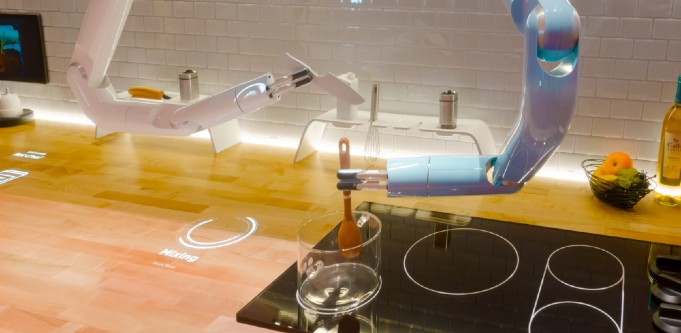
The Samsung Bot Chef. Source: Samsung.
As you may have noticed, CES 2020 recently saw Las Vegas swamped with innovators, tech nerds and creators. It’s an annual festival of wild and wacky debuts and announcements, of extravagant demos and displays, and 2020 was no different.
IBM announced it has doubled the power of its quantum computer for the second year running, and wowed many attendees with its sheer, shiny presence. The Impossible Group made news with a meat-free sausage. But, as we watched Twitter from afar, these are the innovations that really stood out.
Transport
Sony somewhat unexpectedly revealed its entrance into the electric vehicle market, including, of course, 360-degree ‘reality audio’. Hyundai, however, went a big step further, announcing its partnership with Uber, and unveiling the prototype of the flying taxi they’re building together. With a 49-foot wingspan, the flying cab will accommodate four passengers, and could travel up to 180 miles per hour.
Sony surprised crowds at #CES2020 by unveiling an electric car prototype.
— World of Engineering (@engineers_feed) January 8, 2020
Forty-nine feet. That’s the wingspan of the air taxi that Hyundai and Uber hung from the rafters at #CES. Piloted by one person and able to swallow four passengers, it‘ll take them up to 180 mph. Learn more: https://t.co/TUmcX953lV #CES2020 pic.twitter.com/EgKWI22uZD
— WIRED (@WIRED) January 9, 2020
Sextech
Last year, sextech startup Lora DiCarlo had its CES innovation award revoked, sparking international debate about double standards when it comes to sex toys.
This year, not only was Lora DiCarlo allowed to exhibit, but the prior debacle opened the floodgates for all manner of other woman-focused sextech. From DIY programmable vibrators to sex toy pinky rings, this was arguably the year CES acknowledged women’s sexuality, and we are on board. Wired has a great wrap-up here.
Wearable translator
New York startup Waverly Labs presented its wearable translator technology. Two in-ear buds allow users to engage in two-way conversations, with the speaker’s chat translated instantly into the listener’s ear. According to TechCrunch, up to four buds can be used with one smartphone, at the same time.
The translator is expected to be on the market in April, for a mere $US200 ($288).
Delivery robots
CES2020 saw Agility Robotics launch its two-legged Digit robot onto the market, announcing it is now officially for sale, as well as naming Ford Motor Company as its first customer. The two companies are looking at pairing autonomous delivery vehicles with the robot, which has the ability to carry packages the final few feet to the front door.
Food prep robots
Elsewhere, there were robots roaming all over the kitchen.
First, pizza bots that actually, IMHO, don’t look any faster than their human counterparts.
We have pizza bots! #ai #CES2020 pic.twitter.com/7PkMO3zy30
— Evan Kirstel (@evankirstel) January 8, 2020
Second, Samsung revealed its Bot Chef, offering a literal extra pair of hands in the kitchen, to add seasoning, open cupboards and dice your veggies.
There were, of course, also robots to serve you beers, wines, or something a little stronger, and all kinds of intelligent countertops and vertical farming systems. The Spoon has a good kitchen tech round-up here.
And more robots
Samsung also debuted its super-realistic AI human chatbot Neon, as well as ‘Ballie’, a tiny, tennis ball of a life companion, which can remind you about meetings, act as a fitness assistant, or patrol your home.
.@Samsung has created an artificial human chatbot called Neon. #CES2020 pic.twitter.com/JfyG6CGP1P
— Digital Trends (@DigitalTrends) January 8, 2020
Meanwhile, Robosen Robotics debuted its transformer robots with an android flashdance, and Omron laid down the challenge of challenges, inviting techies to take on its ping-pong-playing robot.
This ping pong robot is challenging some serious manhoods at CES.#ces2020 pic.twitter.com/d6VxZtRJcm
— Strange Parts (@strangepartscom) January 9, 2020
Tech for number two
Charmin (yep, the loo roll brand) also demoed some new tech, including a RollBot that swiftly delivers you a new roll of TP, so you need never be caught short again. The company’s SmellSense system analyses air quality and offers a ‘go/no go’ analysis, while the V.I.Pee event portaloo comes equipped with VR, allowing you to continue watching what’s going on on stage.
NOW READ: Blazing trails and dreaming big: StartupSmart’s 12 startups to watch in 2020


COMMENTS
SmartCompany is committed to hosting lively discussions. Help us keep the conversation useful, interesting and welcoming. We aim to publish comments quickly in the interest of promoting robust conversation, but we’re a small team and we deploy filters to protect against legal risk. Occasionally your comment may be held up while it is being reviewed, but we’re working as fast as we can to keep the conversation rolling.
The SmartCompany comment section is members-only content. Please subscribe to leave a comment.
The SmartCompany comment section is members-only content. Please login to leave a comment.